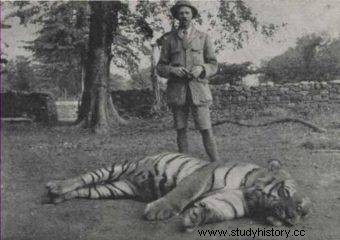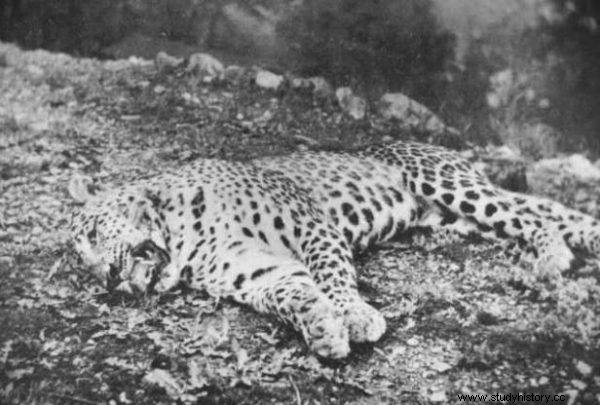He targeted beasts that took a taste for human flesh. It was his bullets that killed a tigress from Champawat, India with at least 434 victims. No wonder Jim Corbett has gone down in history as a man-eater slayer - and one of the most famous hunters of all time.
Jim Corbett was born in British India in 1875 as one of sixteen children of Christopher Corbett. He was passionate about the natural world from an early age. He could sit for hours in the woods, he recognized the sounds of birds and other jungle animals. It happened that he spent the night among the trees by a modest fire. In the future, he wanted to become a tracker and hunter. This childhood dream began to be realized in the army, where he often volunteered to hunt man-eaters.
India at the turn of the nineteenth and twentieth centuries was the "dream" place for the realization of such ambitions. Man-eater hunters had something to do. The number of victims of predator attacks was growing exponentially. . In natural conditions, big cats do not like "humans", but their tendency to hunt humans grew when the Indian villages, under the influence of the demographic boom, grew more and more.

Jim Corbett with one of his victims
Besides, tigers and leopards hunted livestock. It happened that a farmer who tried to scare the "attackers" fell victim to them himself. Superstitious Hindus believed that predators would not want to taste anything else after they had eaten the "guys". And it happened often, but not because of the action of demons or other supernatural forces, but rather the fact that especially older or less agile (e.g. previously wounded) animals chose an easier target - people.
Ludojad from Champawat
The skilled tracker would soon face the real beast on his own. In the Champawat district of northern India, the Bengal tiger hunted the inhabitants. The man-eater's grim fame spread throughout the country. He killed over 400 people. The enormous, weighing over 150 kilograms, three-meter-long animal terrorized the area. It was so impudent that it hunted in the daytime, near human settlements. Most of his victims were women and children. The tigress (because it was a female) first prowled in Nepal, then - when the army was involved in the hunt - changed the hunting grounds to Champawat. Authorities announced a high reward for shooting the beast.
Corbett was 21 when, at the urging of a colleague, decided to take on the task. The young hunter tracked the tigress for several months. He managed to find the animal after traces of blood and a gruesome find . In the jungle, he encountered bitten off fragments of children's limbs. After that, he became sure that the man-eater was close. He finally stood in front of the tigress near the Chataar Bridge, on the road between Champawat and Lohaghat.
At the sight of the predator, he calmly folded and tried on. He killed the female with one shot. After the animal had died, Corbett walked over to examine it closely. The cause of the attacks on people became clear after he checked his dentition. The tigress had completely damaged fangs, possibly due to a shot. So she chose to hunt a much easier "game" - people.
Jim Corbett, who freed the Indians from the beast, became famous and immediately began to receive new orders. The local villagers called him sadahu, that is, saints. Interestingly, he did not take a penny for shooting a man-eater. He resigned from the award. Later, throughout his professional life, he did this.

In 20 years, Corbett has shot over 30 big cats hunting people
In 20 years, Corbett has shot more than 30 large cats hunting humans. All these animals developed a taste for human flesh, some so much so that they could even break into houses to attack terrified victims. It is estimated that the predators killed by Corbett killed at least 1,500 people.
He never hunted for skins or entertainment. He decided to target beautiful, albeit predatory cats only when they were a deadly threat to humans. The reason for their love of "people" was usually the same - their inability to "normally" hunt. Elderly, disabled individuals (often with wounds inflicted by hunters), sick individuals - with progressive infections, wounds of paws, incomplete dentition - remained the man eaters.
Panther of Rudraprayag
Corbett considered his greatest success the shooting of a leopard that prowled around Rudraprayag in the Himalayan foothills of northern India. Since 1925, the animal has killed 125 people in seven years. It was so terrible that religious Hindus completely gave up pilgrimages on the road between the Kedarnath and Badrinath temples, fearing attacks. For a long time, the predator was hunting pilgrims who were walking along this route.
When the pilgrimages were stopped, he moved closer to human settlements. During periods of particularly intense activity, the villagers did not leave their homes at all, but the houses were not a safe haven either. . The leopard has learned to break open doors, climbed through windows, and even scratched holes in walls with its claws. It was so onerous that the matter was based on the British Parliament! The authorities decided to involve Corbett - then the famous man-eating tamer.
The hunter tracked his victim for 10 weeks. He was helped by the Gurkhas - Nepalese serving in the British army and famous for their great courage. Finally, on May 2, 1926, the leopard died. It happened after ten days of waiting on a tree near the bait - tied to a goat post. On the eleventh night, the predator grazed the game. The silence was broken by the sound of a bell attached to the goat's neck and the roar of a wounded animal. Corbett fired. He did not come down from the tree for many hours. However, it later turned out that the shot was accurate. A man-eater was lying near the bait.
Environmental Killer
Corbett has come face to face with the beast more than once - quite literally. This was the case in April 1930, when he was hunting a tigress in the area of the village of Kala Agar in northern India. Corbett left the bait - a buffalo tied to a pole. Sam tried to climb a nearby hill to set up a shooting position there.

Corbett's house in India
On the way to the top, the tigress suddenly emerged from the forest behind him. It all took a fraction of a second. From the corner of his eye he caught a long red and black shape emerging from the green. He turned and instinctively pulled the trigger. The rifle fired. At the same moment he closed his eyes, convinced that he was about to feel claws on his body. The attack, however, did not take place. The body of the predator was lying on the ground a meter from the hunter.
Corbett hunted the last man-eater in 1937. Then he swapped the shotgun for a camera. He left behind many photos and valuable knowledge about the behavior of wild cats. During the war, he served in the army, but as a man in his sixties, for obvious reasons, he did not come to the front. Instead, he trained soldiers in the art of jungle survival. After the war, he gave lectures, published articles and books, and was involved in nature conservation in India. He established a foundation and contributed to the creation of the first national park in this country - in the Ramgangi River Valley, which was named after him.
Bibliography:
- Jim Corbett: Man-eaters of Cumaon . Atra World 2016.
- Jim Corbett: Man-eater Leopard of Rudraprayag . Atra World 2016.
- Jim Corbett: Temple Tiger and Other Cumaon Man-Eating Tales . Atra World, 2016.
